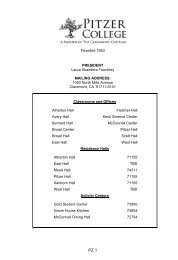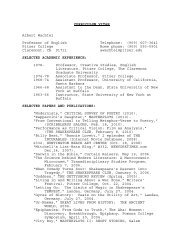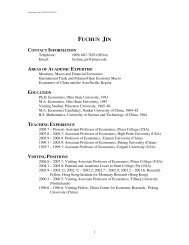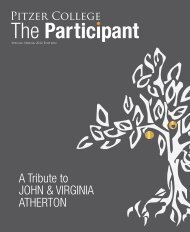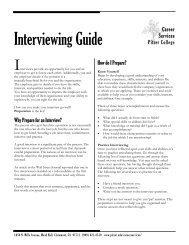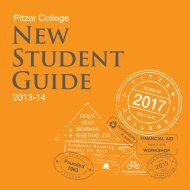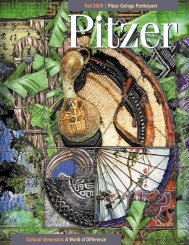Fall 2003 Participant - Pitzer College
Fall 2003 Participant - Pitzer College
Fall 2003 Participant - Pitzer College
Create successful ePaper yourself
Turn your PDF publications into a flip-book with our unique Google optimized e-Paper software.
stint of field research particularly<br />
challenging. As it turned out, I spent<br />
most of my time with Jungarrayi, but<br />
also spent time forging relationships<br />
with the next generation of elders; men<br />
more my age.”<br />
Faulstich said Nyirripi is a much<br />
larger community now than when he<br />
first visited. It now has a fluctuating<br />
population of about 150, but when he<br />
first visited there were only about three<br />
families living in the area.<br />
“In 1980 there were no permanent<br />
structures, only ‘humpies,’ which are<br />
makeshift dwellings. Now there are<br />
cinderblock houses, a dirt airstrip, a<br />
store, a petrol pump, and other<br />
amenities. It is easy to lament these<br />
changes, but in some ways the<br />
community is more vibrant now,”<br />
Faulstich said.<br />
“I like to believe that my work does<br />
advance understandings of human-nature<br />
interactions,” he said. “Anthropologists,<br />
for example, have long struggled to<br />
temporally place the Aboriginal<br />
conception of the Dreaming [Jukurrpa in<br />
Warlpiri]. They have discussed<br />
‘Dreamtime’ as a time-out-of-time; an<br />
era when past, present, and future fold<br />
together. But from my experience, what<br />
matters most to Aboriginals — at least<br />
to Warlpiri — is where Dreaming events<br />
occur, not when, and what they reveal<br />
about Aboriginal socio-political life. In<br />
this way, culture is spatially anchored<br />
and places are indispensable resources<br />
for cultural identity. It’s not<br />
breakthrough research; we just need<br />
more of it.”<br />
Faulstich said he thinks his project<br />
will have broad benefits to <strong>Pitzer</strong>’s<br />
international resources and programs.<br />
“My research has resulted in<br />
ethnographic information and theoretical<br />
explication of some cultural<br />
understandings of ecological principles.<br />
Results of my project are being<br />
disseminated at academic symposia and<br />
research journals, as well as local<br />
community forums. More significant is<br />
that dissemination is occurring in the<br />
classroom, as I share the fruits of my<br />
research with students. Additionally, a<br />
Web site that I am constructing focusing<br />
on “Worldview and Natural History”<br />
[under the aegis of an<br />
International/Intercultural Learning<br />
through Technology grant from the<br />
Mellon Foundation] will host much of<br />
the analyzed material from my project,”<br />
he said.<br />
“Through the Fulbright Scholar<br />
Program, I’m exploring ways of<br />
translating my experience into long-term<br />
institutional impact. Examples include<br />
development of joint curriculum,<br />
summer seminars for students, faculty,<br />
and administrators, and student and<br />
faculty exchanges. I’m still hoping to<br />
one day be able to take a group of<br />
students with me to Australia,” Faulstich<br />
said.<br />
Place-making is not confined to the<br />
Warlpiri or other Aboriginal people,<br />
Faulstich said.<br />
“There are certainly examples of<br />
place-making here, but the context and<br />
motivation differ significantly from the<br />
Aboriginal example. One case in point<br />
that springs to mind is student activism<br />
around preserving the field station. They<br />
are engaged in a process of coming to<br />
know the place they inhabit. Defending<br />
wildness as they are enables us to renew<br />
an ancient covenant with the land.”<br />
“The Claremont Unified School<br />
District is also engaging their students in<br />
developing a sense of place,” Faulstich<br />
said. “In conjunction with <strong>Pitzer</strong> and the<br />
Leadership in<br />
A sculpture<br />
mimics<br />
nature in<br />
the Desert<br />
Garden<br />
section of<br />
the <strong>Pitzer</strong><br />
Arboretum.<br />
Environmental<br />
Education<br />
Partnership, they are<br />
sending students to<br />
the field station to<br />
study our native<br />
ecosystem,” he said.<br />
Though Faulstich<br />
was dismayed to<br />
learn of the death of<br />
several of the<br />
Warlpiri with whom<br />
he had worked in the<br />
past, there were<br />
moments that<br />
transcended such<br />
loss.<br />
“The single best<br />
moment was being in<br />
the field with my two<br />
daughters, laying in<br />
our sleeping bags,<br />
marveling at the<br />
Milky Way and<br />
listening to dingoes<br />
howling. My children<br />
were remarkable in<br />
the field, always<br />
ready for a hike, a<br />
climb, or an<br />
adventure [even<br />
giving me advice on<br />
field<br />
methodologies!],” he said.<br />
“My Fulbright experience has been<br />
among the richest and most valued of<br />
my professional life,” he added.<br />
“Perhaps the most exciting outcome, for<br />
me, has been the incubation of myriad<br />
ideas. The opportunity to engage with a<br />
diversity of students, scholars, and<br />
Aboriginals was tremendous, and I know<br />
that the fruits of these encounters will<br />
enrich my teaching and research for the<br />
rest of my career.”<br />
Jay Collier<br />
<strong>Fall</strong> <strong>2003</strong> 13



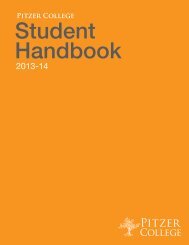

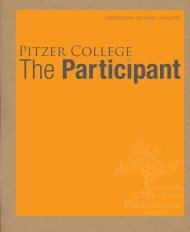
![Anticipated Courses SP14 [pdf] - Pomona College](https://img.yumpu.com/25363335/1/190x245/anticipated-courses-sp14-pdf-pomona-college.jpg?quality=85)

